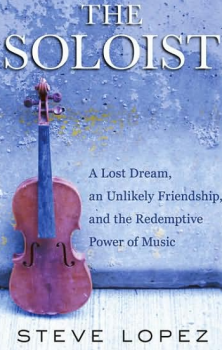The Soloist, by Steve Lopez
 Editor's Abstract
Editor's Abstract
Since I do lot of teaching I read a lot of books. Not all of them are music-related, but a high proportion of them are. From time to time in this space I’ll be posting reviews of books I’ve read, with the hope that 1) you’ll be able to sort through books more quickly (as to whether you really want to spend the time reading them) and 2) you’ll read something that you might not have otherwise considered. Enjoy!
Yvonne Caruthers
I’m always intrigued by books about music, and when I saw the title of this book, The Soloist, I thought it was a fiction book. Was I ever wrong. This book is a parallel to A Beautiful Mind, the book and movie that came out several years ago about mathematician John Nash and his struggles with mental illness. In The Soloist, the main character is not a well-known professional with a good job, but a homeless man, and it’s not math but music which is the underlying talent.
Steve Lopez is a journalist for the LA Times. One day while trying to dream up an idea for yet another column, he was intrigued by one of the homeless people he encountered, who was playing a violin. That alone seemed unusual to Lopez, but the fact that the man seemed to be practicing something emboldened him to strike up a conversation. One encounter led to another and Lopez did indeed write a column about the homeless man. He verified facts that the man had told him (that he used to be a Juilliard student, that he came from Cleveland) and little by little was drawn into the homeless man’s life.
The story of their relationship is harrowing and uplifting in equal measures. Lopez wrote several columns for the LA Times about Nathaniel Ayers (the street musician), a series that galvanized the mayor of Los Angeles to re-think the city’s attitude toward, and treatment of, homeless people, many of whom, like Mr. Ayers, suffer from some type of mental illness.
I personally know a few people who struggle with schizophrenia, and it’s not an easy illness to treat. Mr. Ayers experienced his schizophrenic break from reality while he was a student at Juilliard, causing him to leave the school. However, his music training provided Lopez (and mental health professionals) with a “hook” to pull Ayers back into a more stable living situation, rather than remaining homeless. (I think it’s important to mention that Mr. Ayers was in his 50’s when Lopez wrote this book, and some schizophrenics achieve a more stable life by that point in their illness. I doubt that this book could have been written if Lopez had met Ayers when Ayers was in his 20’s).
Lopez’s book is compelling on two levels – his research into the world of mental illness, and his entry into the world of classical music. In order to understand the world Ayers lives in, Lopez spends a night sleeping on the sidewalks. To understand the musical world Ayers left behind, Lopez visits Juilliard and tries to imagine the music the young man had practiced as he looked out of a particular window. I can’t tell you if his descriptions of mental illness are accurate (they seem so from my second-hand experiences), but I can tell you that Lopez’s descriptions of the world of classical music are dead-on. The combination of the two makes this book a terrific read: I literally couldn’t put it down.
One of the other aspects of the book that I found compelling was that Lopez doesn’t sugar-coat any of the story. He was thrilled when he was able to secure permission to attend an open rehearsal of the LA Philharmonic with Mr. Ayers, a real high for both of them, and again when a member of the orchestra offered to give Ayers free lessons. Lopez even invited Ayers to his house for Easter, but a few days later when Ayers loudly berated him for a perceived offense, Lopez realized that the mental illness of the man was not gone, merely absent for a few days or hours, and that he never knew which side of the person he would encounter.
When the book ended I found myself wondering what happened next: did Ayers continue to improve, were there times when he abandoned his apartment and moved back to the streets, did he keep practicing, how were the lessons?

Leave a Comment: